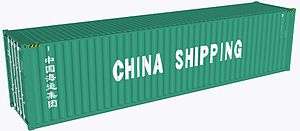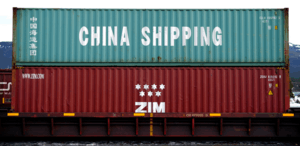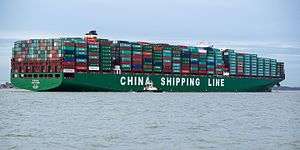China Shipping Container Lines
China Shipping Container Lines Co., Ltd (CSCL; SEHK: 2866, SSE: 601866), was a containerized marine shipping company, based in Shanghai, China.
 | |
 | |
Native name | 中海集装箱运输股份有限公司 |
|---|---|
| Public | |
| Traded as | |
| ISIN | CNE100000536 |
| Industry | Shipping and logistics |
| Fate | Merged and rebranded |
| Successor | COSCO |
| Founded | 1997 |
| Headquarters | , People's Republic of China |
| Services |
|
| Parent | China Shipping Group |
| Website | en |
An ongoing downturn in the container shipping industry which began in 2013, and that was caused by various factors such as weak global GDP, muted demand for container shipping, sluggish global trade growth, and container vessel overcapacity left the container shipping market crippled.[1][2] The slump has precipitated a wave of mergers and acquisitions coupled with reshuffled vessel sharing alliances as container lines scramble to stay financially viable. Consequently; due to the decline in the industry, CSCL's parent China Shipping Group entered advanced merger talks with its larger government-owned compatriot, the COSCO Group in October 2015.[3] By late December 2015, the two announced a formal merger after regulatory and antitrust approval. The integration plan stipulated that CSCL will withdraw its involvement in the container shipping business and cease to operate as a carrier; instead it is destined to become a container leasing and financial-asset management company.[4] Meanwhile, COSCO Group's container shipping division; COSCO Container Lines (renamed COSCO Shipping Lines), is expected to take over as the sole operator of the vessel fleet. Furthermore, as part of the reconfiguration plan, the CSCL brand was abandoned and renamed as COSCO Shipping Development in an effort to align the company with its new identity in the merged mega-entity.[5]
The new company formed by the integration of China Shipping and COSCO; now known as China COSCO Shipping, aims to expand its fleet size to more than 2 million TEUs by 2018, which would make it the world's third-largest container carrier in terms of vessel capacity.[6]
Corporate affairs
CSCL, established in 1997, provided fully containerized marine and intermodal freight transport, storage, and electronic data interchange services worldwide. The company called on ports across the world, and more than 30 ports from South China to North China in its domestic coastal business. It also operated container yards and trucks, international cargo agencies, and terminal facilities in many countries. North American freight services included refrigerated cargo carriage in the line's own reefer container fleet, as well as other specialized cargo container services. CSCL continued to grow rapidly until it became the eighth largest container line at its peak after acquiring minority interest in Asia Pacific Marine Container Lines of Canada. Its fleet comprised over 150 vessels, with a total operating capacity of 600,000 twenty-foot equivalent units (TEU).[7]

As part of the integration with COSCO, all of CSCL's North American offices ceased operations in June 2016.
Additionally, CSCL and UASC (United Arab Shipping Company) cooperated on the Asia-Europe-Asia trade route by sharing vessel space in order to cut costs and improve efficiency. Both companies also ordered 5 ships bigger than the Maersk Triple E class. In 2014, CSCL and UASC entered a new vessel sharing partnership, dubbed the Ocean Three alliance, alongside the French CMA CGM.[8]
It was announced in July 2016 that the Ocean Three alliance will be dismantled by March 2017 because of the CSCL-COSCO merger and because UASC reported a merger with Hapag-Lloyd. Furthermore, CMA CGM declared it will launch a new vessel sharing alliance; called the Ocean Alliance in March 2017 which will include Evergreen Line and OOCL. The new China COSCO Shipping is expected to also join the Ocean Alliance.[9][10]
Gallery
 CSCL Globe at the Port of Felixstowe, U.K.
CSCL Globe at the Port of Felixstowe, U.K. CSCL Manzanillo in Port Angeles, USA
CSCL Manzanillo in Port Angeles, USA- Bow of the CSCL Jupiter, one of the container ships operated by CSCL
 CSCL Europe near Glameyer Stack
CSCL Europe near Glameyer Stack CSCL Mars output Port of Hamburg, on the Elbe
CSCL Mars output Port of Hamburg, on the Elbe CSCL Venus on the Elbe with Destination Hamburg
CSCL Venus on the Elbe with Destination Hamburg Container ship CSCL Saturn in approach, Port of Hamburg
Container ship CSCL Saturn in approach, Port of Hamburg
See also
- Xin Los Angeles
- Chinese shipping
References
- http://www.joc.com/maritime-news/profit-warning-issued-cimc-market-downturn-persists_20160715.html
- "Container Shipping Hits Bottom -Drewry".
- https://www.wsj.com/articles/cosco-china-shipping-group-in-advanced-merger-talks-1444840906
- http://www.joc.com/maritime-news/cscl-plan-exit-box-business-raises-o3-alliance-question_20151213.html
- "CSCL to get a new name as it shifts focus from boxes to finance".
- "CSCL to get a new name as it shifts focus from boxes to finance".
- "Company Profile". CSCL. Archived from the original on 22 January 2013. Retrieved 6 January 2013.
- "Shipping Industry Consolidation Set to Continue, Says CMA CGM Executive" Wall Street Journal, 3 December 2014. Accessed: 12 December 2014.
- https://www.cma-cgm.com/news/1137/cma-cgm-cosco-container-lines-evergreen-line-and-orient-overseas-container-line-to-establish-ocean-alliance-
- "Merged Cosco-CSCL: Shipper contracts valid until new alliance launches".